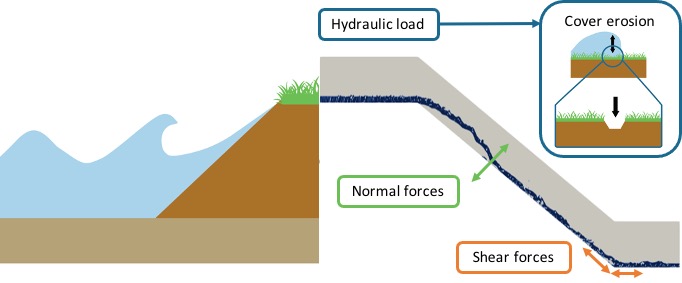V.M. van Bergeijk1*, J.J. Warmink1, S.J.M.H. Hulscher1
1 University of Twente
*corresponding author:
Introduction
Grass-covered flood defences are globally used as coastal protection. Wave overtopping is one of the main failure mechanisms of these flood defences. During storms, waves can flow over the crest and accelerate along the landward slope resulting in high hydraulic loads that can lead to erosion of the cover (Figure 1). Climate change can increase the amount of wave overtopping and decrease the strength of the grass cover. For example, higher design water levels are expected due to sea level rise while increasing droughts in summer reduce the strength of the grass cover and underlying clay layer. Therefore, it is important to develop tools for wave overtopping that can take both changes in the load and the strength into account to assess the safety of grass-covered flood defences.
Methods
We developed a numerical model to simulate the overtopping flow over grass-covered flood defences in OpenFOAM (Van Bergeijk et al., 2022). Separate overtopping volumes are simulated to identify important hydraulic processes and locations of high hydraulic load. The numerical model is used to develop formulations for the hydraulic load that can be used in a probabilistic framework to calculate the failure probability of grass-covered flood defences. In this framework, the distribution for the grass cover strength was adapted to study the effect of reduced cover strength due to droughts.
Results
Two important hydraulic processes were identified. Firstly, the flow can separate at the landward crest line resulting in high normal forces at the reattachment location. Secondly, high flow velocities at the toe result in high shear forces. Therefore, the upper slope and the toe are vulnerable locations for cover erosion by overtopping waves. The probabilistic calculations showed that a good grass cover is extremely important to protect the flood defence against erosion. Damages to the grass cover can increase the failure probability by a factor 3000 for flood defences with a long fetch length as is the case for coastal flood defences (Van Bergeijk et al., 2021). The developed methods can be used to study innovative covers to make coastal defences more climate proof such as flower rich species or geogrid.

Figure 1: Model simulation of the overtopping wave indicating locations of high hydraulic load.
Acknowledgements
This work is part of the research programme All-Risk, with project number P15-21, which is (partly) financed by the Netherlands Organisation for Scientific Research (NWO).
References
Van Bergeijk, V. M., Warmink, J. J., & Hulscher, S. J. M. H. (2021). The wave overtopping load on landward slopes of grass-covered flood defences: deriving practical formulations using a numerical model. Coastal Engineering, 171(3),
Van Bergeijk, V., Verdonk, V. A., Warmink, J., & Hulscher, S. J. M. H. (2021). The Vulnerability of Damaged River and Lake Dikes for Wave Overtopping. FLOODrisk2020.
I. Surname1*, F.N. Another-Surname2 , Y. Next-Surname2
1 University Name, Country; 2 Organization Name, Country
* Corresponding author: mail.name@organization.org


